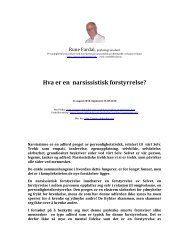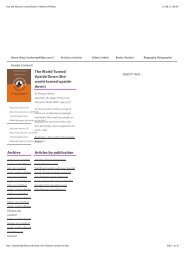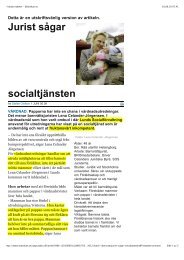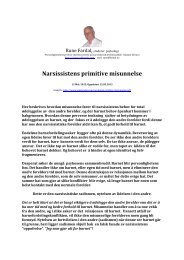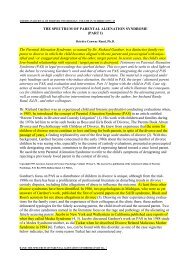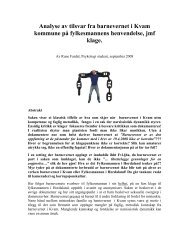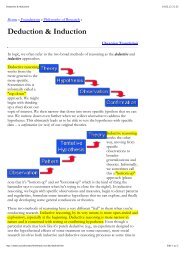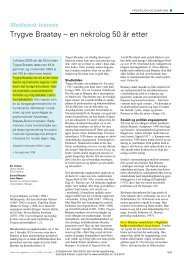The origins of narcissism and narcissistic personality disorder a
The origins of narcissism and narcissistic personality disorder a
The origins of narcissism and narcissistic personality disorder a
Create successful ePaper yourself
Turn your PDF publications into a flip-book with our unique Google optimized e-Paper software.
66 JOHN S. AUERBACH<br />
In addition, mutual gazing between mother <strong>and</strong> infant, an ability<br />
that emerges by the second month <strong>of</strong> life, is central to the communicative<br />
process. In this process, it is the mother who tends to gaze<br />
steadily, while the infant controls the dialogue by making <strong>and</strong> breaking<br />
visual contact, by looking at mother <strong>and</strong> looking away (Stern, 1977).<br />
In this early stage <strong>of</strong> development, communication occurs through cycles<br />
<strong>of</strong> matching, disruption, <strong>and</strong> repair (Beebe & Lachmann, 1988;<br />
Gianino & Tronick, 1988; Lachmann & Beebe, 1989; Tronick, 1989).<br />
Thus, Beebe <strong>and</strong> Gerstman (1980; see also Beebe & Stern, 1977) have<br />
constructed a scale <strong>of</strong> mother-infant affective facial engagement. At<br />
the top <strong>of</strong> the scale is the gape smile (scale point 90); at the bottom is<br />
an inhibition <strong>of</strong> responsivity, with a limp, motionless drooping <strong>of</strong> the<br />
head <strong>and</strong> an aversion <strong>of</strong> gaze (scale point 10). In general, mothers <strong>and</strong><br />
infants match on the direction <strong>of</strong> change, positive or negative, but avoid<br />
an exact match on the level <strong>of</strong> the scale; the overall process is controlled<br />
by mutual regulation (Beebe & Lachmann, 1988; see also Cohn &<br />
Tronick, 1988).<br />
Tronick (1989; Gianino & Tronick, 1988) reports that cycles <strong>of</strong> matching,<br />
disruption, <strong>and</strong> repair, in which mother <strong>and</strong> infant move from<br />
matched affective states to unmatched states <strong>and</strong> back again, can <strong>and</strong><br />
usually occur within a span <strong>of</strong> less than 1 second. Lachmann <strong>and</strong> Beebe<br />
(1989) propose that these cycles <strong>of</strong> match, mismatch, <strong>and</strong> repair constitute<br />
a presymbolic source <strong>of</strong> experiences <strong>of</strong> oneness, experiences that<br />
may provide affective content to (healthy) <strong>narcissistic</strong> fantasies, <strong>and</strong> <strong>of</strong><br />
a sense <strong>of</strong> self. Specifically, matches <strong>and</strong> repairs may be related to the<br />
sense <strong>of</strong> oneness in later life, <strong>and</strong> mismatches, if not too intense, may<br />
be related to a sense <strong>of</strong> a separate self. On the other h<strong>and</strong>, intense<br />
mismatches, as in the still-face experiment (Tronick, Als, Adamson,<br />
Wise, & Brazelton, 1978), in which a mother attempts to maintain a<br />
deliberately still face instead <strong>of</strong> a normal interactive facial display, or<br />
pervasive mismatches, in the form <strong>of</strong> the chase-<strong>and</strong>-dodge interaction<br />
reported by Beebe <strong>and</strong> Stern (1977), are significant disruptions <strong>of</strong> mutual<br />
regulation. In the short term, as in the still-face experiment, they<br />
result in infant distress, <strong>and</strong> a sequence <strong>of</strong> mismatches, as in chase<strong>and</strong>-dodge<br />
interaction, results in infant disengagement through gaze<br />
aversion. In the longer term, it is hypothesized, the infant begins to<br />
internalize not a sense <strong>of</strong> a separate self but instead a representation<br />
<strong>of</strong> derailment (Spitz, 1964) or <strong>of</strong> interactive misregulation.




